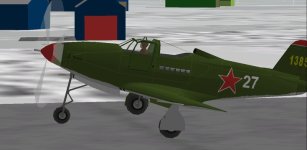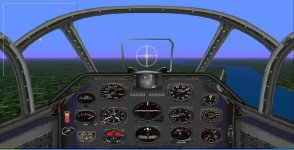aleatorylamp
Charter Member
Hello Ivan,
The Curtiss Electric Propeller used on some of the Airacobras seems to be the most elusive of all pieces of information.
Some of the different performance tests mentioned on http://www.wwiiaircraftperformance.org/P-39/P-39.html, make
reference to propeller pitch, or blade angle range, and blade design number, but if they are going to be useful to you is
another matter.
I´m looking now, and this information is mentioned for the -C, the -D, -M, -N, and -Q variants, but unfortunately there
there are no -F or -K versions mentioned, I´m afraid.
However, the -M version is mentioned as having a V-1710-83 engine and "a three-bladed Curtiss Electric constant speed
propeller, blade design No. 614-1C-1-5-21, blade angle range 26º to 56º, at 42 inch radius."
This is the only piece of information detailing numbers for a Curtiss Electric Propeller that I´ve come across. I believe the
-M version was a derivative of a more commonly named other version, but off-hand I can´t remember which.
One relationship between Tables 512 and 511 that I do realize, is something you mentioned some time ago, and is clearly
visible on your BV-141B propeller tables, namely that for any given pitch angle, the curves on both tables drop to zero
at the same "J" Factor.
Now: Were I to
1.- give, in Table 512, the 35º pitch-angle Graph (and perhaps move it to be 34º), at "J" Factor 1.77
(or 1.8, to round off), a Power Coefficient of 0.1422, then
2.- even out the rest of the graph curve shape for J=1.8, and after that
3.- put all the rest of the graphs to zero at the points coinciding with the propeller efficiency table, and finally
4.- "sculpture" the rest of the graphs to fit the surrounding shapes.
...perhaps that would not be so meaningless, and would have a good effect. Then next step would be to do
something similar for the 40º pitch graph and finally for the 25-30º one, but not at the "J" Factor positions you
mention for your P39F, but for the "J" Factor corresponding to the calculation of the P39D-2 propeller 1.4 ft
approximation with 2:1 gear ratio I´m working with.
I wonder...
Cheers,
Aleatorylamp
The Curtiss Electric Propeller used on some of the Airacobras seems to be the most elusive of all pieces of information.
Some of the different performance tests mentioned on http://www.wwiiaircraftperformance.org/P-39/P-39.html, make
reference to propeller pitch, or blade angle range, and blade design number, but if they are going to be useful to you is
another matter.
I´m looking now, and this information is mentioned for the -C, the -D, -M, -N, and -Q variants, but unfortunately there
there are no -F or -K versions mentioned, I´m afraid.
However, the -M version is mentioned as having a V-1710-83 engine and "a three-bladed Curtiss Electric constant speed
propeller, blade design No. 614-1C-1-5-21, blade angle range 26º to 56º, at 42 inch radius."
This is the only piece of information detailing numbers for a Curtiss Electric Propeller that I´ve come across. I believe the
-M version was a derivative of a more commonly named other version, but off-hand I can´t remember which.
One relationship between Tables 512 and 511 that I do realize, is something you mentioned some time ago, and is clearly
visible on your BV-141B propeller tables, namely that for any given pitch angle, the curves on both tables drop to zero
at the same "J" Factor.
Now: Were I to
1.- give, in Table 512, the 35º pitch-angle Graph (and perhaps move it to be 34º), at "J" Factor 1.77
(or 1.8, to round off), a Power Coefficient of 0.1422, then
2.- even out the rest of the graph curve shape for J=1.8, and after that
3.- put all the rest of the graphs to zero at the points coinciding with the propeller efficiency table, and finally
4.- "sculpture" the rest of the graphs to fit the surrounding shapes.
...perhaps that would not be so meaningless, and would have a good effect. Then next step would be to do
something similar for the 40º pitch graph and finally for the 25-30º one, but not at the "J" Factor positions you
mention for your P39F, but for the "J" Factor corresponding to the calculation of the P39D-2 propeller 1.4 ft
approximation with 2:1 gear ratio I´m working with.
I wonder...
Cheers,
Aleatorylamp












